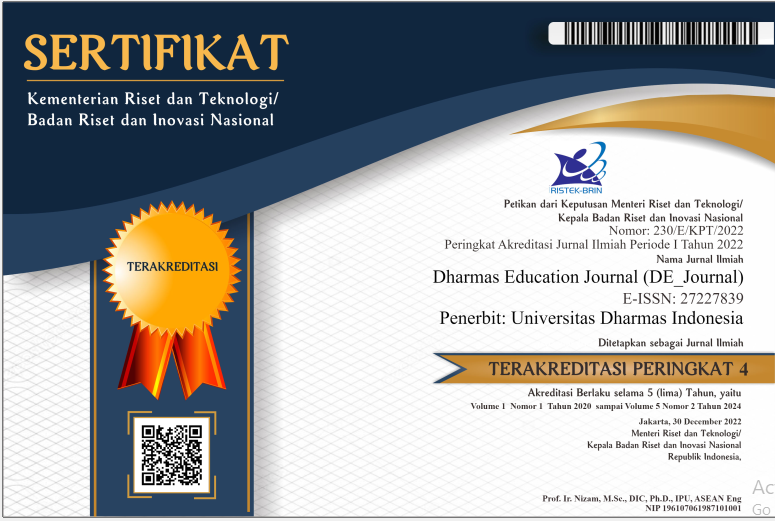LANGKAH-LANGKAH PEMECAHAN MASALAH, BRANSTORMING, JARINGAN AFINITAS, DIAGRAM SEBAB AKIBAT
DOI:
https://doi.org/10.56667/de_journal.v4i3.268Kata Kunci:
Langkah-Langkah Pemecahan Masalah, Branstorming, Jaringan Afinitas, Diagram sebab akibatAbstrak
Jaringan afinitas berperan penting dalam mengelompokkan ide-ide hasil brainstorming ke dalam struktur yang logis dan sistematis. Proses pengelompokan ini memungkinkan terbentuknya hubungan makna antara ide, sehingga memudahkan dalam mengidentifikasi akar masalah dan menyusun strategi pemecahan yang lebih terarah.Metode brainstorming terbukti efektif dalam menggali sebanyak mungkin ide dari berbagai individu dengan latar belakang pemikiran yang berbeda. Proses ini mampu menstimulasi kreativitas kolektif dan menghasilkan masukan awal yang kaya untuk ditindaklanjuti dalam tahap analisis berikutnya.Gabungan antara brainstorming dan jaringan afinitas membentuk alur pemikiran yang komprehensif, mulai dari pencarian ide mentah hingga penyusunan solusi berdasarkan pola yang muncul dari keterkaitan ide. Hal ini mempercepat proses pengambilan keputusan sekaligus meningkatkan kualitas solusi yang dihasilkan.Penerapan metode ini turut membentuk budaya partisipatif dan kolaboratif dalam kelompok, di mana setiap peserta memiliki ruang yang setara untuk berkontribusi. Selain menghasilkan solusi, metode ini juga berperan dalam membangun empati, komunikasi dua arah, dan kesadaran kolektif terhadap permasalahan yang dihadapi.Metode ini sangat cocok digunakan dalam konteks organisasi, pendidikan, dan manajemen sosial yang membutuhkan pendekatan partisipatif dan berbasis pada pengalaman nyata pelaku lapangan. Efektivitasnya tidak hanya terletak pada hasil akhir, tetapi juga pada proses yang membangun kapasitas berpikir kritis dan kerja tim secara simultan.
Unduhan
Referensi
Alt, D., Kapshuk, Y., & Dekel, H. (2023). Promoting perceived creativity and innovative behavior: Benefits of future problem-solving programs for higher education students. Thinking Skills and Creativity, 47, 101201. https://doi.org/10.1016/j.tsc.2022.101201
Bellaera, L., Weinstein-Jones, Y., Ilie, S., & Baker, S. T. (2021). Critical thinking in practice: The priorities and practices of instructors teaching in higher education. Thinking Skills and Creativity, 41, 100856. https://doi.org/10.1016/j.tsc.2021.100856
Chaijum, N. (2020). Using Brainstorming through Social Media to Promote Engineering Students’ Teamwork Skills. European Journal of Science and Mathematics Education, 8(4), 170–176. http://www.scimath.net
Du, K., Li, X., Tao, M., & Wang, S. (2020). Experimental study on acoustic emission (AE) characteristics and crack classification during rock fracture in several basic lab tests. International Journal of Rock Mechanics and Mining Sciences, 133, 104411. https://doi.org/10.1016/j.ijrmms.2020.104411
Fisk, A. D., Czaja, S. J., Rogers, W. A., Charness, N., & Sharit, J. (2020). Designing for older adults: Principles and creative human factors approaches. CRC press.
Gafour, O. W. A., & Gafour, W. A. S. (2020). Creative thinking skills–A review article. Journal of Education and e-Learning, 4(1), 44–58.
Göttgens, I., & Oertelt-Prigione, S. (2021). The application of human-centered design approaches in health research and innovation: a narrative review of current practices. JMIR mHealth and uHealth, 9(12), e28102.
Guaman-Quintanilla, S., Everaert, P., Chiluiza, K., & Valcke, M. (2023a). Impact of design thinking in higher education: a multi-actor perspective on problem solving and creativity. International Journal of Technology and Design Education, 33(1), 217–240. https://doi.org/https://doi.org/10.1007/s10798-021-09724-z
Guaman-Quintanilla, S., Everaert, P., Chiluiza, K., & Valcke, M. (2023b). Impact of design thinking in higher education: a multi-actor perspective on problem solving and creativity. International Journal of Technology and Design Education, 33(1), 217–240. https://doi.org/10.1007/s10798-021-09724-z
Hamilton, D., McKechnie, J., Edgerton, E., & Wilson, C. (2021). Immersive virtual reality as a pedagogical tool in education: a systematic literature review of quantitative learning outcomes and experimental design. Journal of Computers in Education, 8(1), 1–32. https://doi.org/10.1007/s40692-020-00169-2
Han, W., & Abdrahim, N. A. (2023). The role of teachers’ creativity in higher education: A systematic literature review and guidance for future research. Thinking Skills and Creativity, 48, 101302. https://doi.org/10.1016/j.tsc.2023.101302
Handayani, N. D., & Mantra, I. B. N. (2022). BRAINSTORMING AS AN EFFECTIVE STRATEGY TO IMPROVE STUDENTS’WRITING SKILLS. Journal on Studies in English Language Teaching (JOSELT), 3(2), 34–42.
Haryanti, D. U., Indah, R. N., & Wahyuni, S. (2021). ENHANCING ORAL PROFICIENCY USING THREE STEPS INTERVIEW TECHNIQUE FOR ELEVENTH GRADERS. Journal of Languages and Language Teaching, 9(1), 61. https://doi.org/10.33394/jollt.v9i1.3271
Holeman, I., & Kane, D. (2020). Human-centered design for global health equity. Information Technology for Development, 26(3), 477–505. https://doi.org/10.1080/02681102.2019.1667289
Hou, B., Wang, F., Liu, T., & Wang, Z. (2021). Reproductive toxicity of polystyrene microplastics: In vivo experimental study on testicular toxicity in mice. Journal of Hazardous Materials, 405, 124028. https://doi.org/10.1016/j.jhazmat.2020.124028
Karunarathne, W., & Calma, A. (2024). Assessing creative thinking skills in higher education: deficits and improvements. Studies in Higher Education, 49(1), 157–177. https://doi.org/10.1080/03075079.2023.2225532
Ku, B., & Lupton, E. (2022). Health design thinking: creating products and services for better health. mit Press.
Lee, J. H., Ostwald, M. J., & Gu, N. (2020). Design thinking: creativity, collaboration and culture (Vol 12). Springer.
Muratovski, G. (2021). Research for designers: A guide to methods and practice.
Pyzdek, T. (2021). Problem Solving Tools. In The Lean Healthcare Handbook: A Complete Guide to Creating Healthcare Workplaces (bll 177–183). Springer.
Shields, H. J., Traa, A., & Van Raamsdonk, J. M. (2021). Beneficial and Detrimental Effects of Reactive Oxygen Species on Lifespan: A Comprehensive Review of Comparative and Experimental Studies. Frontiers in Cell and Developmental Biology, 9, 628157. https://doi.org/10.3389/fcell.2021.628157
Tsai, M.-N., Liao, Y.-F., Chang, Y.-L., & Chen, H.-C. (2020). A brainstorming flipped classroom approach for improving students’ learning performance, motivation, teacher-student interaction and creativity in a civics education class. Thinking Skills and Creativity, 38, 100747. https://doi.org/10.1016/j.tsc.2020.100747
Widiastuti, I. A. M. S., Murtini, N. M. W., & Anto, R. (2022). Brainstorming as an Effective Learning Strategy to Promote Students’ Critical Thinking Skills. Jurnal Pendidikan Progresif, 12(2), 969–971. https://doi.org/10.23960/jpp.v12.i2.202243
Xu, Z., & Dang, Y. (2020a). Automated digital cause-and-effect diagrams to assist causal analysis in problem-solving: a data-driven approach. International Journal of Production Research, 58(17), 5359–5379. https://doi.org/10.1080/00207543.2020.1727043
Xu, Z., & Dang, Y. (2020b). Automated digital cause-and-effect diagrams to assist causal analysis in problem-solving: a data-driven approach. International Journal of Production Research, 58(17), 5359–5379. https://doi.org/10.1080/00207543.2020.1727043
Diterbitkan
Cara Mengutip
Terbitan
Bagian
Lisensi
Hak Cipta (c) 2025 Dharmas Education Journal

Artikel ini berlisensi Creative Commons Attribution-NonCommercial-NoDerivatives 4.0 International License.
Makalah yang disampaikan diasumsikan tidak mengandung bahan propietary yang tidak dilindungi oleh hak paten














